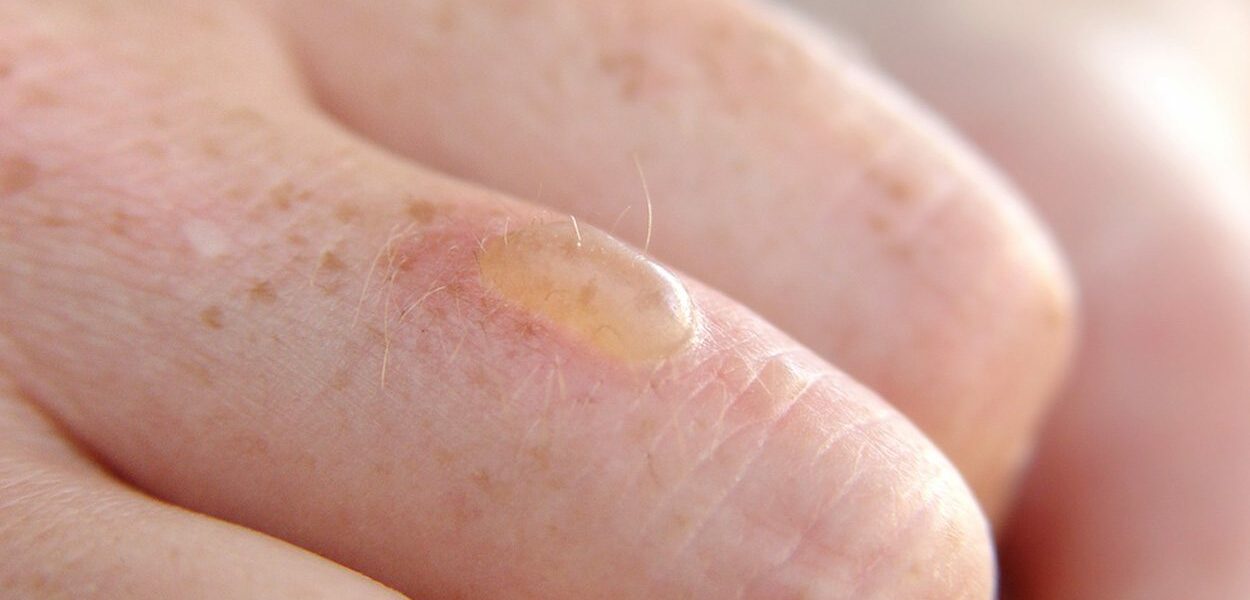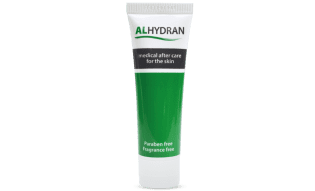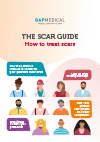How to treat a burn blister?
Burn blisters are painful and worrying. If treated incorrectly, they can lead to infection or scarring. In this article, You will learn how to manage them step by step, and how ALHYDRAN supports skin recovery once the wound has closed.
What is a burn blister?
A burn blister is a bubble filled with clear fluid that forms after your skin has been exposed to heat, friction, cold, or chemicals. It develops when the outer layer of the skin detaches and fluid collects underneath. This bubble acts as a natural protection for the sensitive new skin beneath.
Burn blisters typically appear with second-degree burns, especially the superficial type. In these burns, the top layer of the skin (epidermis) is damaged, but the deeper layer (dermis) remains largely intact. The body reacts by letting fluid (plasma) accumulate between those layers, creating a small pocket that cushions and protects the healing skin.
In contrast:
- First-degree burns (like sunburn) only cause redness and pain, but no blisters.
- Deep second-degree or third-degree burns can destroy the deeper skin layers, leaving no intact surface for a blister to form.
Common causes include:
- Hot water or steam
- Contact with hot surfaces or flames
- Chemical burns
- Friction or frostbite
How to care for a burn blister (step-by-step)
How to care for a burn blister (step-by-step)
Proper care makes a significant difference in how well your skin heals. The following steps show you how to treat a burn blister safely and support natural recovery.
- Cool the burn immediately
Place the affected area under lukewarm running water for about 20 minutes. This limits damage and relieves pain. Do not use ice or very chilly waterwhich can harm the skin.
- Avoid popping the blister
The blister is your skin’s protective barrier. Popping it too soon exposes the wound to infection and slows down burn recovery.
- Cover the blister
After cooling, cover it loosely with a sterile, non-stick dressing. Replace the dressing daily or whenever it becomes wet or dirty.
- Care for the skin around the blister
If the surrounding skin feels tight, red, or dry, you can apply a hydrating medical cream such as ALHYDRAN.
Important: apply ALHYDRAN only to closed wound, never on an open blister.
ALHYDRAN is widely used in hospitals and burn centres. It hydrates deeply, supports the skin barrier, and reduces symptoms such as tightness, dryness, redness, and itching.
- If the blister bursts
If the blister opens accidentally take care to:
- Wash your hands before touching the area
- Clean gently with water and mild disinfectant
- Trim loose skin with sterile scissors
- Cover with paraffin gauze or a sterile dressing
- Avoid sticking plasters directly on the wound
See a doctor if you notice pus, spreading redness, swelling, or fever.
Stages of burn blister healing
- Formation: fluid collects under damaged skin.
- Protection: the intact blister shields new skin.
- Rupture: the blister may break naturally.
- New skin formation: new skin develops underneath.
- Drying and peeling: the blister dries and flakes off.
Once the wound has fully closed, applying ALHYDRAN two to three times a day supports overall recovery and helps minimise scar formation.
When to see a doctor?
Seek medical attention if:
- the blister is larger than your palm
- the burn affects face, joints, hands, or genitals
- you notice signs of infection
- the wound hasn’t healed within two weeks
- the patient is a baby or young child
How ALHYDRAN supports recovery
ALHYDRAN is a Medical Moisture Retention Cream (MMRC) — a scientifically developed cream designed to deeply hydrate and restore the skin barrier. This medical formulation combines fresh Aloe Vera gel, natural oils, and vitamins to retain moisture within the skin while preventing excessive water loss.
This balanced effect of hydration and protection helps vulnerable skin recover after a burn. It reduces dryness, redness, tightness, and itching, supporting the skin’s natural healing process and helping to prevent visible scarring.
Because of this proven balance between hydration and occlusion, burn centres and therapists across Europe use ALHYDRAN as part of standard aftercare for closed wounds and healing scars.
Conclusion
Burn blisters may look minor, but correct treatment is essential to prevent infection and scarring. Always cool the area, protect the blister, and avoid breaking it. Once the skin has healed, applying ALHYDRAN helps restore hydration, reduce complaints, and support long-term recovery.
Literature
- Hoeksema, H., & Monstrey, S. (2013). Scar management by means of occlusion and hydration: A comparative study of silicones versus a hydrating gel-cream. Burns, 39(6), 1437–1448. https://doi.org/10.1016/j.burns.2013.03.025
- Ziegenthaler, H. (2010). Effect of scar treatment products on unpleasant physical manifestations in patients suffering from extensive burn scarring. 28th Annual Conference of the German-speaking Working Group for Burns Treatment (DAV), Schladming.
- Rijkenberg, R. (2015). Use of ALHYDRAN cream in the treatment of burn scars following a chemical explosion: A case study. European Burns Association (EBA).
- Sukan, C. (2014). Case ALHYDRAN: Hot water burn (scald). Lotus MDC, Ankara, Turkey.
- Klotz, T., Kurmis, R., Munn, Z., Heath, K., & Greenwood, J. E. (2017). The effectiveness of moisturisers for the management of burn scars following severe burn injury: A systematic review. JBI Database of Systematic Reviews and Implementation Reports, 15(1), 15–29. https://doi.org/10.11124/JBISRIR-2016-003141


